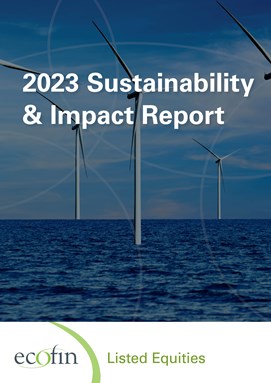
Brent Newcomb
President
The Inflation Reduction Act & Climate Investing – good for the environment, good for business
Many of you have read the headlines and maybe a few reports on the outcomes of the Inflation Reduction Act. You’ve heard the superlatives and skepticism.
Our business, Ecofin, has invested in the energy transition space for a long time. Many of our strategies were designed for the economic benefits of the global energy transition. Yes, doing so addresses climate change, but the growth opportunities in this space are captivating.
We love the enablers; companies, projects and services that enable decarbonization at scale. This space received a boost and should see rising demand from the IRA. As we explain, this should attract a lot of non-U.S. companies to invest domestically, increasing the value-added content and domestication of GDP. In doing so, the energy transition may become less divisive and more economically potent.
So we are bullish on the IRA, but let’s be specific about why. Pure, blind government support is never sustainable. What are the intentions of the IRA?
5 things first
- First, there is a lot in this bill. On the other hand, you can clearly see the objectives – energy security and
combating climate change.
- Second, it should have an impact over decades to come.
- Third, the headline support of $369 billion is a small degree of the total economic impact. From corporations
to individuals, expect a lot of spending into the many trillions.
- Fourth, the devil is in the details, but there was intent to give foundational support to clean energies, proven
and emerging, without being too prescriptive. This gives flexibility. Because how we live, use energy, and
naturally the costs, will change as we innovate.
- Fifth, energy transitions are not straight lines. This law doesn’t address everything we felt it should. It has
some misses, such as not addressing the structural needs of the U.S. power grid. But, it allows economics
and growth to rule.
Breaking it down
- $370 billion spending in two major areas. While not as large as Build Back Better, this is the largest
government spending on clean energy ever.
- First is logical - sensible extensions of existing spending programs with upgrades in wind, solar, biofuels,
and more.
- Second is innovation – spending in areas like electrification, storage, green hydrogen, CCS. The latter two of
which are still nascent.
- You could differentiate the benefits among electrons and molecules. Either way, it’s pro-American energy.
- It’s both corporate and residential. Solar panels, heat pumps, electric vehicles, energy efficiency down to
hard-to-abate sectors.
- You should look at U.S. ‘processes’, whether it’s industrial, manufacturing, or transportation, as being derisked
if they are decarbonizing. If not, expect higher costs and perhaps penalties.
- Finally, you should see a positive feedback loop around renewables. Growth of storage, green hydrogen,
CCUS, and more upstream manufacturing going domestic provide reasons to build out more renewables. In
turn, this incentivizes more training & education on renewables’ role, which creates more expertise, drives
further investment and R&D.
What investors should know
- First, investing pro-environment in the U.S. has never been better. The benefits & risks have come into
clearer focus. Any fundamental investor will appreciate that.
- Second, this should be positive for the renewable value chain.
- This is a green light to deploy capital that was on hold.
- Capital intensive businesses need visibility. The IRA gives 10 years of visibility, which is an impetus for new
areas of the renewable ecosystem, including storage and green hydrogen.
- We expect to see unprecedented level of investment in the sector over the next decade. Expect to see
new partnerships across fertilizer, transportation, industrial, manufacturing. And perhaps vertical integration
across clean electrons and molecules.
- Third, this should be positive for electrification and U.S. technology.
- We believe this moves electricity companies into a growth phase for a sector that has seen no demand
growth for over a decade.
- The emphasis on electricity supply, such as storage, is intended to take advantage of the inherent one two
punch from renewables and electrification to decarbonize and lower overall power prices.
- Between the IRA and CHIPS and Science Act, manufacturing will likely be done in the U.S.
Some outgrowths
There are a couple of things we would have like included. But let’s focus on the clear intents:
- U.S. ‘champion’ companies: It will likely create U.S. champions. Today, most global leaders in the
renewables and energy transition value chain are Chinese (e.g., batteries, solar) or European (e.g.,
wind turbines, offshore wind, electric cables, heat pumps). This bill supports localized expertise and
manufacturing to create the next global leaders.
- U.S. jobs: There should be a lot of local jobs created. Companies, even incumbents in the energy industry,
will pivot strong to reap the rewards and get first mover advantage. They will need a lot of new skills.
- U.S. competitiveness: If jobs aren’t enough, the economics of the energy transition are just as tantalizing.
Countries are in an arm’s race for the fruits of decarbonization, energy security and electrification.
- Achieving cheap scale: One comparison of the IRA is the experience with wind. The tax incentives
for wind have delivered significant, cheap wind with compelling cost declines – that will go further in
the decades ahead with or without incentives – further improving renewables on a levelized cost of
energy basis. This law is trying to do that across a range of technologies that, hopefully, result in seismic
reductions in emissions and costs.
Ecofin Advisors Limited (“Ecofin UK”) is authorized and regulated by the Financial Conduct Authority and is also registered with the U.S. Securities and Exchange Commission as an investment advisor. This commentary contains certain statements that may include “forward-looking statements.” All statements, other than statements of historical fact, included herein are “forward-looking statements.” Although Ecofin UK believes that the expectations reflected in these forward-looking statements are reasonable, they do involve assumptions, risks and uncertainties, and these expectations may prove to be incorrect; actual events could differ materially from those anticipated in these forward-looking statements as a result of a variety of factors. You should not place undue reliance on these forward looking statements, which speak only as of the date of this publication. Ecofin UK does not assume a duty to update these forward-looking statements. The views and opinions in this commentary are as of the date of publication and are subject to change. This material should not be relied upon as investment or tax advice and is not intended to predict or depict performance of any investment or any fund managed by Ecofin UK. This publication is provided for information only and shall not constitute an offer to sell or a solicitation of an offer to buy any securities.












Ecofin Editorial: Inflation Reduction Act